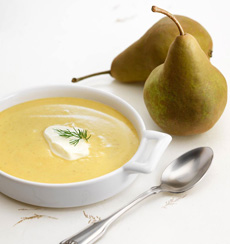TIP OF THE DAY: Pears At Every Fall Meal
|
Who doesn’t like to bite into a perfectly ripe pear, soft to the touch, dripping with juice? Whether in a packed lunch or as a grab-and-go snack, pears are one of the delights of fall.
But pears don’t have to be ripe to be delicious. Hard pears can be baked, cooked (especially poached), even grated as a garnish onto cake, pudding, pancakes and yogurt. Here are suggestions from USA Pears, the national trade association, for incorporating pears into cooked recipes. There are many delicious pear recipes on the organization’s website. At the least, treat yourself to pear purée, the pear version of applesauce that can be served at any time during the day, as a condiment, side, topping or dessert. You can also use it in pear-accented cocktails. Peartini, anyone? Here’s a quick recipe to try with a ripe pear. A hard pear can be cooked first. RECIPE: NO-COOK SIMPLE PEAR PURÉE Ingredients For 1 Serving 1. PEEL and core the pear. You can leave the skin on the pear; it will provide vibrant flecks of color in the purée. 2. CUT into chunks and purée in a food processor or blender until smooth. The splash of lemon juice helps prevent the purée from browning. 3. TASTE and adjust for sweetness as needed. Add a dash of cinnamon as desired. |
TOP PHOTO: Pear-Butternut Squash Soup. BOTTOM PHOTO: Pear Purée (like applesauce). Images courtesy USA Pears. |
|
|
Preparation For Hard Pears Poach the pears before pureeing. Pears can be poached in red and white wine, fruit juice, beer, sake, coconut milk or water. Add some spice to your poaching liquid: cloves, cinnamon, salt, black pepper, vanilla bean, orange zest, nutmeg, cardamom. 1. PEEL THE pears, leaving stem and core intact. Heat the poaching liquid over medium heat until it starts to simmer. Reduce the heat to low and continue simmering while fully immersing pears into the poaching liquid. Simmer until pears are soft and easily pierced with a fork, 5 to 15 minutes depending on the size of the pear. 2. REMOVE the pears from liquid and let cool. Core the pears, remove the stems, cut into chunks and purée in a food processor or blender until smooth. Taste and adjust sweetness; add spices as desired.
|
||

|
PEAR RECIPES FOR DINNER
|
|
|
THE HISTORY OF PEARS Pears are one of the world’s oldest cultivated and beloved fruits. The trees thrive in cool temperate climates, and there is evidence of pears as food since prehistoric times. Many traces of it have been found in Switzerland’s prehistoric lake dwellings. [Source] In the pear genus Pyrus, some 3,000 varieties are grown worldwide, The tree is thought to have originated in present-day western China, and to have spread to the north and south along mountain chains. In 5000 B.C.E., one Chinese diplomat was so enamored of them that he resigned his post to develop new varieties. In The Odyssey, the Greek poet Homer lauds pears as a “gift of the gods.” Roman farmers documented extensive pear growing and grafting techniques. Pliny’s Natural History recommended stewing them with honey and noted three dozen varieties. Seventeenth-century Europe saw a great flourishing of pear cultivation, especially in Belgium and France. Many of the modern varieties began to emerge. Early colonists brought the first pear trees to America’s eastern settlements, where they thrived until crop blights proved too severe to continue widespread cultivation. Fortunately, pioneers had brought pear trees brought to Oregon and Washington in the 1800s, where they thrived in the agricultural conditions of the Pacific Northwest. It remains the major pear-growing center of the U.S.
|
||





